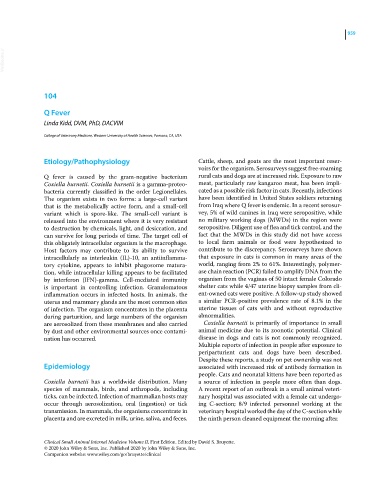Page 1021 - Clinical Small Animal Internal Medicine
P. 1021
959
VetBooks.ir
104
Q Fever
Linda Kidd, DVM, PhD, DACVIM
College of Veterinary Medicine, Western University of Health Sciences, Pomona, CA, USA
Etiology/Pathophysiology Cattle, sheep, and goats are the most important reser-
voirs for the organism. Serosurveys suggest free‐roaming
Q fever is caused by the gram‐negative bacterium rural cats and dogs are at increased risk. Exposure to raw
Coxiella burnetii. Coxiella burnetii is a gamma‐proteo- meat, particularly raw kangaroo meat, has been impli-
bacteria currently classified in the order Legionellales. cated as a possible risk factor in cats. Recently, infections
The organism exists in two forms: a large‐cell variant have been identified in United States soldiers returning
that is the metabolically active form, and a small‐cell from Iraq where Q fever is endemic. In a recent serosur-
variant which is spore‐like. The small‐cell variant is vey, 5% of wild canines in Iraq were seropositive, while
released into the environment where it is very resistant no military working dogs (MWDs) in the region were
to destruction by chemicals, light, and desiccation, and seropositive. Diligent use of flea and tick control, and the
can survive for long periods of time. The target cell of fact that the MWDs in this study did not have access
this obligately intracellular organism is the macrophage. to local farm animals or food were hypothesized to
Host factors may contribute to its ability to survive contribute to the discrepancy. Serosurveys have shown
intracellularly as interleukin (IL)‐10, an antiinflamma- that exposure in cats is common in many areas of the
tory cytokine, appears to inhibit phagosome matura- world, ranging from 2% to 61%. Interestingly, polymer-
tion, while intracellular killing appears to be facilitated ase chain reaction (PCR) failed to amplify DNA from the
by interferon (IFN)‐gamma. Cell‐mediated immunity organism from the vaginas of 50 intact female Colorado
is important in controlling infection. Granulomatous shelter cats while 4/47 uterine biopsy samples from cli-
inflammation occurs in infected hosts. In animals, the ent‐owned cats were positive. A follow‐up study showed
uterus and mammary glands are the most common sites a similar PCR‐positive prevalence rate of 8.1% in the
of infection. The organism concentrates in the placenta uterine tissues of cats with and without reproductive
during parturition, and large numbers of the organism abnormalities.
are aerosolized from these membranes and also carried Coxiella burnetii is primarily of importance in small
by dust and other environmental sources once contami- animal medicine due to its zoonotic potential. Clinical
nation has occurred. disease in dogs and cats is not commonly recognized.
Multiple reports of infection in people after exposure to
periparturient cats and dogs have been described.
Despite these reports, a study on pet ownership was not
Epidemiology associated with increased risk of antibody formation in
people. Cats and neonatal kittens have been reported as
Coxiella burnetii has a worldwide distribution. Many a source of infection in people more often than dogs.
species of mammals, birds, and arthropods, including A recent report of an outbreak in a small animal veteri-
ticks, can be infected. Infection of mammalian hosts may nary hospital was associated with a female cat undergo-
occur through aerosolization, oral (ingestion) or tick ing C‐section; 8/9 infected personnel working at the
transmission. In mammals, the organisms concentrate in veterinary hospital worked the day of the C‐section while
placenta and are excreted in milk, urine, saliva, and feces. the ninth person cleaned equipment the morning after.
Clinical Small Animal Internal Medicine Volume II, First Edition. Edited by David S. Bruyette.
© 2020 John Wiley & Sons, Inc. Published 2020 by John Wiley & Sons, Inc.
Companion website: www.wiley.com/go/bruyette/clinical

